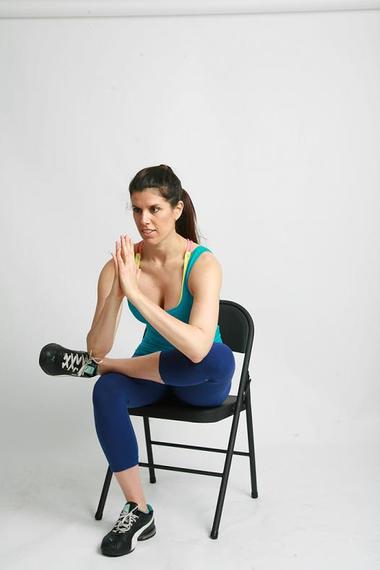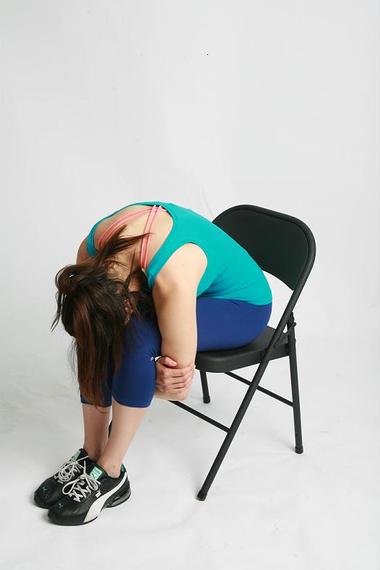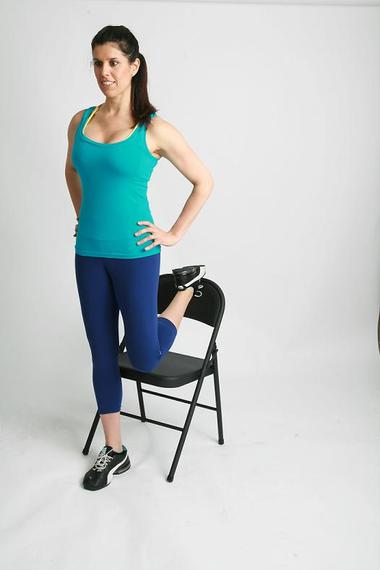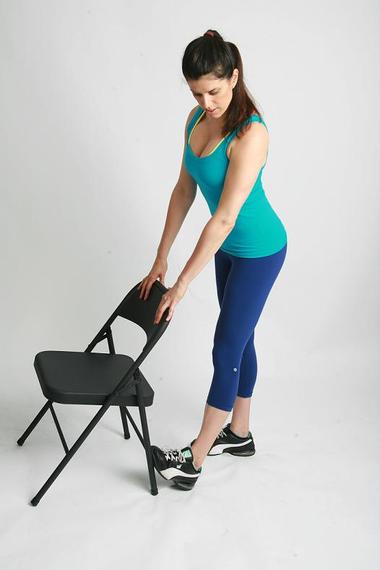Shockingly, back pain is the leading cause of disability in Americans under 45 years old. More than 26 million Americans between the ages of 20-64 experience frequent back pain (1). The main cause? Lack of flexibility and too much sitting. When I ask the question, "How long do you sit in a day?" most answer with, "Not much." However, if we were to tally up the amount of sitting you do throughout the day between your morning commute, your chair time in the office, bathroom time, meetings time, commute back home time, waiting for someone or for an appointment, watching television, sitting down for each meal and all other times you sat today, you would be perplexed to learn about how much you actually sit in a day. The human body is built to move, not sit. So when the accumulation of minutes in a seated position rack up, back inflammation and pain is the result. Therefore, everyone must stretch throughout the day, every day, and not simply rely on the twice a week yoga class or 10-minute post exercise stretch to do the job. Those will not help you at all.
Keep it simple for yourself. Every 20 minutes, pick one of these back sparing stretches to do at your desk. Hold the stretch for 30 seconds (each side if a limb) and then get right back to work.
All you need is a stable chair without wheels and a conscious mind of the time so that you avoid seated postures for too long throughout the day.
Piriformis:

Photo Credit: Xochitl Rodrigue, www.thexgallery.com
Sit on the edge of your seat and cross one leg over the other like a figure four. Flex the foot on the leg that is crossed over the leg. Rest that leg on the thigh, never the knee. With a straight back, lean forward the crossed leg and feel the stretch in the glute on the crossed leg.
Lower Back:

Photo Credit: Xochitl Rodrigue, www.thexgallery.com
Sit on the edge of your chair with your legs together. Lean forward and wrap both arms around your legs. Slowly curve through your spine as you lean forward bringing your forward towards your thighs.
Quad/Psoas:

Photo Credit: Xochitl Rodrigue, www.thexgallery.com
Stand in front of the chair and gently place one foot on the chair behind you. Be sure to keep the standing leg close to the stretched leg so that you can target your thigh and hip flexor in the stretch. Stand erect with your chest lifted and hips tucked under you to maximize the stretch.
Staggered Stance Hamstring/Calf:

Photo Credit: Xochitl Rodrigue, www.thexgallery.com
Bring one foot forward one foot back. Straighten your back leg keeping the back heel on the ground with your toes slightly turned inward. Lunge forward through the front leg and feel the stretch in the back hamstring and calf. Be sure to keep your hips parallel to the ground by keeping your core engaged and tailbone tucked slightly downward.
Calf:

Photo Credit: Xochitl Rodrigue, www.thexgallery.com
On the back of the chair, bring your heel up against the chair leg and with a straight leg, lean your weight forward into the calf that is stretching. Go slow and hold the endpoint of the stretch for 30 seconds.
Lats:

Photo Credit: Xochitl Rodrigue, www.thexgallery.com
Grab the back of the chair with both hands and with your feet hip distanced apart, and an arm length away from the chair, descend your trunk (torso) in between your hands as you sit your hips slightly back while maintaining a slight bend in your knees. To get a deeper stretch, simply place one hand across your body to the opposite side of the chair and perform the same action.
Just think, the more flexible you remain, the less tightness will accumulate in your body. The less tightness, the less pain. The less pain, the happier the life.
(1) National Centers for Health Statistics, Chartbook on Trends in the Health of Americans 2006, Special Feature: Pain. http://www.cdc.gov/nchs/data/hus/hus06.pdf.
Our 2024 Coverage Needs You
It's Another Trump-Biden Showdown — And We Need Your Help
The Future Of Democracy Is At Stake
Our 2024 Coverage Needs You
Your Loyalty Means The World To Us
As Americans head to the polls in 2024, the very future of our country is at stake. At HuffPost, we believe that a free press is critical to creating well-informed voters. That's why our journalism is free for everyone, even though other newsrooms retreat behind expensive paywalls.
Our journalists will continue to cover the twists and turns during this historic presidential election. With your help, we'll bring you hard-hitting investigations, well-researched analysis and timely takes you can't find elsewhere. Reporting in this current political climate is a responsibility we do not take lightly, and we thank you for your support.
Contribute as little as $2 to keep our news free for all.
Can't afford to donate? Support HuffPost by creating a free account and log in while you read.
The 2024 election is heating up, and women's rights, health care, voting rights, and the very future of democracy are all at stake. Donald Trump will face Joe Biden in the most consequential vote of our time. And HuffPost will be there, covering every twist and turn. America's future hangs in the balance. Would you consider contributing to support our journalism and keep it free for all during this critical season?
HuffPost believes news should be accessible to everyone, regardless of their ability to pay for it. We rely on readers like you to help fund our work. Any contribution you can make — even as little as $2 — goes directly toward supporting the impactful journalism that we will continue to produce this year. Thank you for being part of our story.
Can't afford to donate? Support HuffPost by creating a free account and log in while you read.
It's official: Donald Trump will face Joe Biden this fall in the presidential election. As we face the most consequential presidential election of our time, HuffPost is committed to bringing you up-to-date, accurate news about the 2024 race. While other outlets have retreated behind paywalls, you can trust our news will stay free.
But we can't do it without your help. Reader funding is one of the key ways we support our newsroom. Would you consider making a donation to help fund our news during this critical time? Your contributions are vital to supporting a free press.
Contribute as little as $2 to keep our journalism free and accessible to all.
Can't afford to donate? Support HuffPost by creating a free account and log in while you read.
As Americans head to the polls in 2024, the very future of our country is at stake. At HuffPost, we believe that a free press is critical to creating well-informed voters. That's why our journalism is free for everyone, even though other newsrooms retreat behind expensive paywalls.
Our journalists will continue to cover the twists and turns during this historic presidential election. With your help, we'll bring you hard-hitting investigations, well-researched analysis and timely takes you can't find elsewhere. Reporting in this current political climate is a responsibility we do not take lightly, and we thank you for your support.
Contribute as little as $2 to keep our news free for all.
Can't afford to donate? Support HuffPost by creating a free account and log in while you read.
Dear HuffPost Reader
Thank you for your past contribution to HuffPost. We are sincerely grateful for readers like you who help us ensure that we can keep our journalism free for everyone.
The stakes are high this year, and our 2024 coverage could use continued support. Would you consider becoming a regular HuffPost contributor?
Dear HuffPost Reader
Thank you for your past contribution to HuffPost. We are sincerely grateful for readers like you who help us ensure that we can keep our journalism free for everyone.
The stakes are high this year, and our 2024 coverage could use continued support. If circumstances have changed since you last contributed, we hope you'll consider contributing to HuffPost once more.
Already contributed? Log in to hide these messages.





